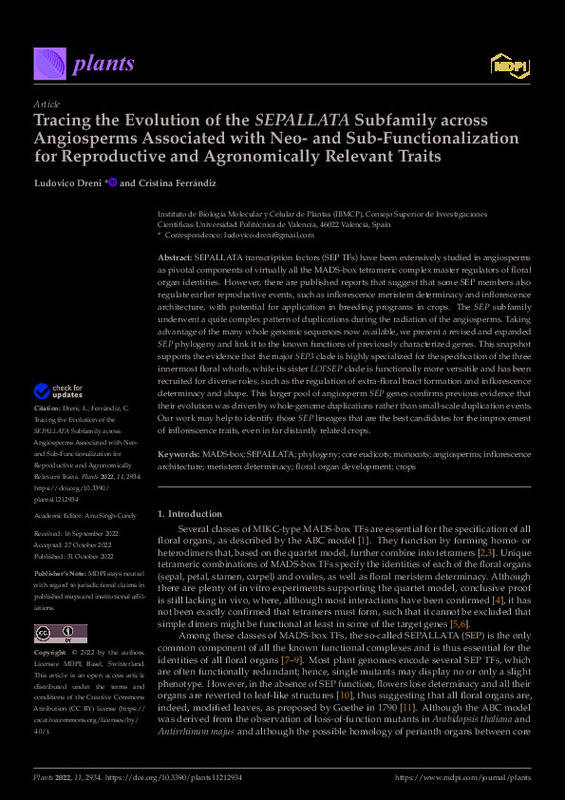JavaScript is disabled for your browser. Some features of this site may not work without it.
Buscar en RiuNet
Listar
Mi cuenta
Estadísticas
Ayuda RiuNet
Admin. UPV
Tracing the Evolution of the SEPALLATA Subfamily across Angiosperms Associated with Neo- and Sub-Functionalization for Reproductive and Agronomically Relevant Traits
Mostrar el registro sencillo del ítem
Ficheros en el ítem
| dc.contributor.author | Dreni, Ludovico
|
es_ES |
| dc.contributor.author | FERRANDIZ MAESTRE, CRISTINA
|
es_ES |
| dc.date.accessioned | 2023-05-10T18:01:32Z | |
| dc.date.available | 2023-05-10T18:01:32Z | |
| dc.date.issued | 2022-11 | es_ES |
| dc.identifier.uri | http://hdl.handle.net/10251/193249 | |
| dc.description.abstract | [EN] SEPALLATA transcription factors (SEP TFs) have been extensively studied in angiosperms as pivotal components of virtually all the MADS-box tetrameric complex master regulators of floral organ identities. However, there are published reports that suggest that some SEP members also regulate earlier reproductive events, such as inflorescence meristem determinacy and inflorescence architecture, with potential for application in breeding programs in crops. The SEP subfamily underwent a quite complex pattern of duplications during the radiation of the angiosperms. Taking advantage of the many whole genomic sequences now available, we present a revised and expanded SEP phylogeny and link it to the known functions of previously characterized genes. This snapshot supports the evidence that the major SEP3 Glade is highly specialized for the specification of the three innermost floral whorls, while its sister LOFSEP Glade is functionally more versatile and has been recruited for diverse roles, such as the regulation of extra-floral bract formation and inflorescence determinacy and shape. This larger pool of angiosperm SEP genes confirms previous evidence that their evolution was driven by whole-genome duplications rather than small-scale duplication events. Our work may help to identify those SEP lineages that are the best candidates for the improvement of inflorescence traits, even in far distantly related crops. | es_ES |
| dc.description.sponsorship | This research was funded by the European Commission through a Marie SklodowskaCurie Individual Fellowship (RI no. 661678 `GainGrain') awarded to L.D. and by CSIC (Spanish National Research Council) through the fellowship `convocatoria extension MSCA IF ERC' awarded to L.D. | es_ES |
| dc.language | Inglés | es_ES |
| dc.publisher | MDPI | es_ES |
| dc.relation.ispartof | Plants | es_ES |
| dc.rights | Reconocimiento (by) | es_ES |
| dc.subject | MADS-box | es_ES |
| dc.subject | SEPALLATA | es_ES |
| dc.subject | Phylogeny | es_ES |
| dc.subject | Core eudicots | es_ES |
| dc.subject | Monocots | es_ES |
| dc.subject | Angiosperms | es_ES |
| dc.subject | Inflorescence architecture | es_ES |
| dc.subject | Meristem determinacy | es_ES |
| dc.subject | Floral organ development | es_ES |
| dc.subject | Crops | es_ES |
| dc.title | Tracing the Evolution of the SEPALLATA Subfamily across Angiosperms Associated with Neo- and Sub-Functionalization for Reproductive and Agronomically Relevant Traits | es_ES |
| dc.type | Artículo | es_ES |
| dc.identifier.doi | 10.3390/plants11212934 | es_ES |
| dc.relation.projectID | info:eu-repo/grantAgreement/EC/H2020/661678/EU | es_ES |
| dc.rights.accessRights | Abierto | es_ES |
| dc.description.bibliographicCitation | Dreni, L.; Ferrandiz Maestre, C. (2022). Tracing the Evolution of the SEPALLATA Subfamily across Angiosperms Associated with Neo- and Sub-Functionalization for Reproductive and Agronomically Relevant Traits. Plants. 11(21):1-17. https://doi.org/10.3390/plants11212934 | es_ES |
| dc.description.accrualMethod | S | es_ES |
| dc.relation.publisherversion | https://doi.org/10.3390/plants11212934 | es_ES |
| dc.description.upvformatpinicio | 1 | es_ES |
| dc.description.upvformatpfin | 17 | es_ES |
| dc.type.version | info:eu-repo/semantics/publishedVersion | es_ES |
| dc.description.volume | 11 | es_ES |
| dc.description.issue | 21 | es_ES |
| dc.identifier.eissn | 2223-7747 | es_ES |
| dc.identifier.pmid | 36365387 | es_ES |
| dc.identifier.pmcid | PMC9656651 | es_ES |
| dc.relation.pasarela | S\487288 | es_ES |
| dc.contributor.funder | European Commission | es_ES |
| dc.contributor.funder | Consejo Superior de Investigaciones Científicas | es_ES |








